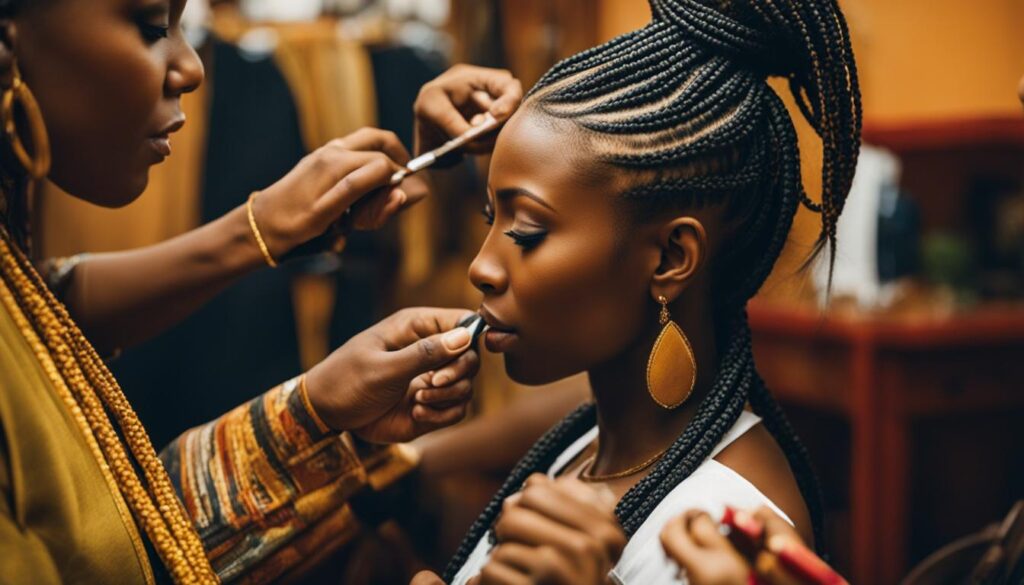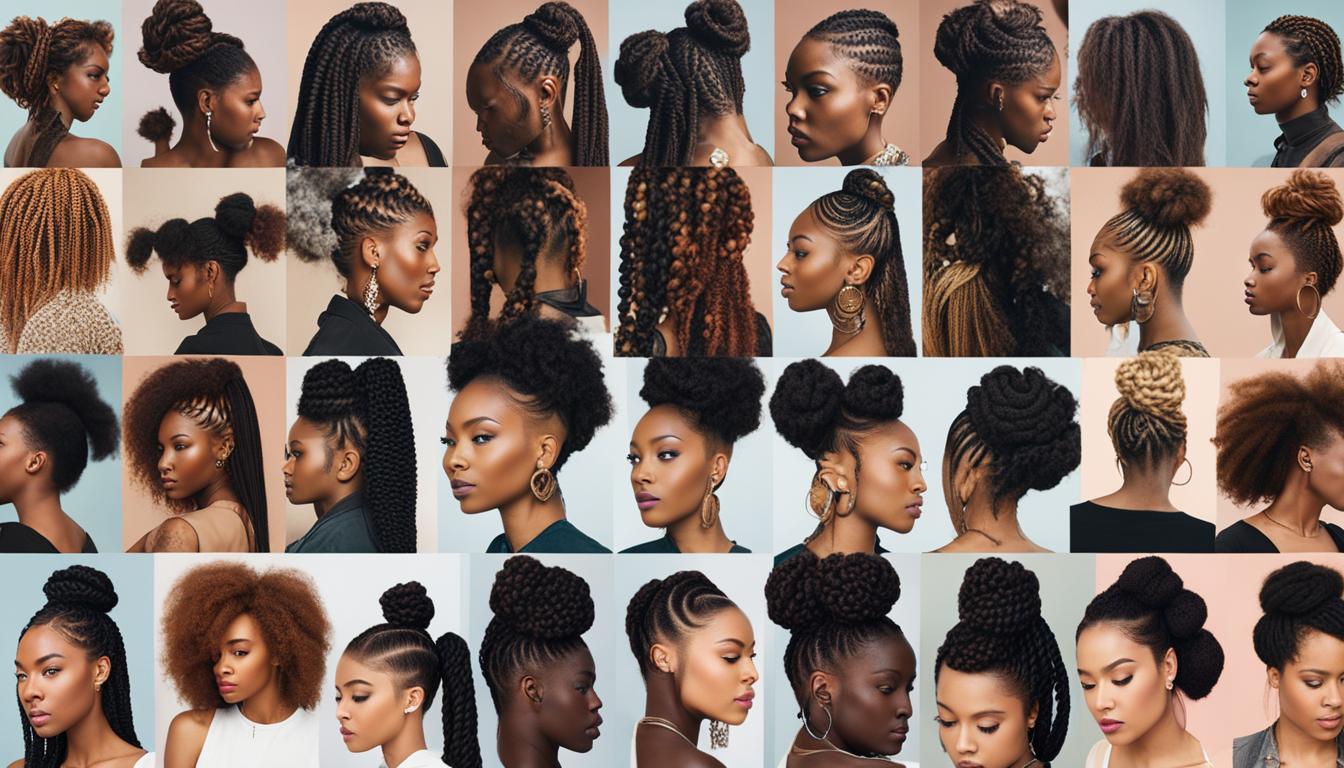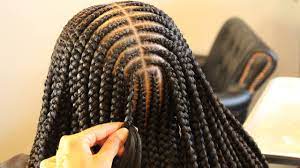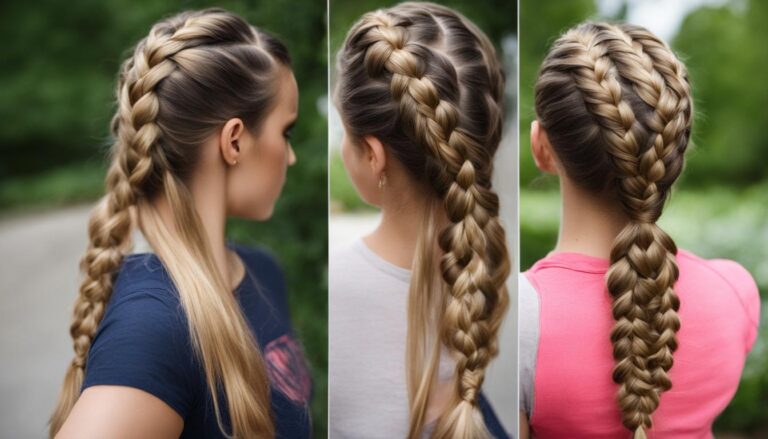Is Braiding Good for African Hair?
Braiding has long been a popular hairstyling technique for African hair, but is it truly beneficial? According to experts, not all braids are considered protective hairstyles. Certain braid styles, such as chunky braids, extensions, or tightly braided styles, can cause damage to the hair follicles and put excessive pressure on the scalp. It is important to choose braiding styles that do not cause tension or damage to the hair and scalp.
Key Takeaways:
- Not all braids are considered protective hairstyles for African hair.
- Choose braiding styles that do not cause tension or damage to the hair and scalp.
- Avoid chunky braids, extensions, and tightly braided styles.
- Consider the health of the scalp and hair follicles when braiding.
- Consult with a stylist who specializes in African hair for the best braiding options.
The Impact of Braiding on Hair Breakage
When it comes to braiding, one of the concerns that often arises is the potential for hair breakage. However, it is important to note that braiding, when done correctly, can actually minimize breakage and promote hair growth. The key lies in understanding the proper techniques and taking care of the scalp and hair while the braids are in place.
Contrary to popular belief, focusing on the midshaft and below when braiding does not necessarily prevent breakage. While it is essential to handle the hair gently during the braiding process, experts suggest that maintaining a healthy scalp is paramount for promoting hair growth and reducing breakage. This means ensuring proper scalp care and avoiding inflammation or other scalp issues that could impede hair growth.
Braids can provide a protective environment for the hair, shielding it from external damage that can lead to breakage. Additionally, braided styles can help distribute the tension more evenly throughout the hair, minimizing the strain on individual strands. By reducing the risk of breakage, braids can actually contribute to healthier hair and encourage growth.
Minimizing Breakage: Key Points
- Focus on maintaining a healthy scalp to promote hair growth
- Avoid hairstyles that cause inflammation or scalp issues
- Select braided styles that distribute tension evenly
- Use braids as a protective measure against external damage
- Follow proper hair care routines while the braids are in place
By understanding and implementing these strategies, individuals can minimize hair breakage and reap the benefits of braiding, such as promoting hair growth and maintaining healthy hair.
The Benefits of Braiding for African Hair
Braiding offers several benefits for African hair. It not only provides a stylish and versatile look but also helps maintain the health of your hair. Here are some key advantages of braiding:
- Protection: Braids act as a protective style, shielding your hair from external elements and reducing the risk of breakage. By keeping your ends tucked away, braids help prevent damage caused by friction and environmental factors.
- Reduced Manipulation: Braided styles are low maintenance, which means less manipulation of your hair. This can be particularly beneficial for African hair, which is often prone to breakage. By reducing daily styling routines, braids allow your hair to rest and grow.
- Moisture Retention: Braiding can help lock in moisture and prevent dryness. The tightness of the braids helps to seal in the natural oils produced by your scalp, keeping your hair hydrated and reducing the risk of frizz.
The Importance of Hair Care While Braiding
While braiding offers numerous benefits, it’s essential to care for your hair while it’s in braids. Moisturizing your scalp regularly with a lightweight oil or leave-in conditioner can help prevent dryness and maintain the health of your hair and scalp. Additionally, protective styling doesn’t mean neglecting your haircare routine. It’s essential to follow a gentle cleansing routine and use sulfate-free shampoos and conditioners. Avoid excessive tension when braiding and opt for looser styles to minimize hair breakage. Lastly, be mindful of the duration that you keep your braids in to prevent damage from prolonged wear.

Tips for Maintaining Healthy Braided Hair
Keeping your braided hair healthy is crucial to ensure it looks great and stays protected. Here are some essential tips and tricks for maintaining healthy braided hair:
1. Gently wash your hair
When washing your braided hair, use a gentle shampoo and conditioner to prevent frizz and build-up. Be sure to focus on the scalp, gently massaging it to remove any dirt or product residue. Rinse thoroughly, ensuring all the shampoo and conditioner are washed out.
2. Moisturize your hair and scalp
Braided hair still requires moisture to stay healthy. Use a lightweight moisturizer or oil to keep your hair and scalp hydrated. Pay special attention to the roots and edges, as they are more prone to dryness. Massage the moisturizer or oil into your scalp to promote blood circulation and nourishment.
3. Avoid tight braiding styles
Choosing the right braiding style is essential for the health of your hair. Avoid styles that are too tight as they can cause tension and damage the hair follicles. Opt for looser braids that allow your scalp to breathe and reduce the risk of breakage. Consult with a stylist who specializes in African hair to determine the best style for you.
4. Give your hair a break
While braided styles can last for weeks, it’s important to give your hair a break between styles. This allows your scalp and hair to rest and recover from the tension of braids. Avoid constantly switching between braided styles to prevent excessive manipulation and potential damage. Embrace your natural hair or try out different protective hairstyles during this break period.
By following these tips, you can maintain healthy braided hair that looks fabulous and promotes hair growth. Remember to prioritize hair care and choose the right braiding style for your African hair to keep it strong and beautiful.
The Versatility and Longevity of Braided Styles
Braided styles are not only a popular choice for African hair but also offer a wide range of versatility and longevity. From classic box braids to trendy cornrows, there are various techniques and styles to suit different preferences and occasions. Braids can be customized to reflect one’s personal style and can be adorned with accessories or colored extensions to add a unique touch.
One of the advantages of braided styles is their long-lasting nature. Once the braids are properly installed, they can last for weeks, reducing the need for daily styling and manipulation. This can be particularly beneficial for individuals with busy schedules or those who prefer low-maintenance hair care routines. Additionally, braids can be a protective style, shielding the hair from external damage and helping to retain moisture.
The Best Braiding Techniques for African Hair
- Box Braids: This classic braiding technique involves sectioning the hair into small squared-off sections and weaving synthetic or natural hair extensions into each section. Box braids are versatile and can be styled in various ways, including updos, ponytails, or left down.
- Cornrows: Cornrows are created by braiding the hair close to the scalp in a continuous, raised pattern. This technique is ideal for individuals who prefer a sleek and low-maintenance look. Cornrows can be worn as intricate designs or simple straight-back styles.
- Twists: Twists involve intertwining two strands of hair together, creating a rope-like effect. This technique can be done with natural hair or extensions and offers a range of styling options, including Senegalese twists, Marley twists, or Havana twists.
When choosing a braiding style, it’s essential to consider factors such as the weight and tension on the scalp. Heavy or overly tight braids can cause discomfort and potential damage to the hair and scalp. Consulting with a stylist who specializes in African hair can help determine the best braiding technique and style that suits individual needs and preferences.

While braided styles offer versatility and longevity, it’s crucial to give the hair a break between braiding styles. Allowing the scalp and hair to rest and recover is essential for maintaining overall hair health. Regular moisturizing of the scalp, protection of the hair at night with a satin scarf or pillowcase, and following proper hair care techniques are also important in ensuring the longevity and health of braided styles.
Conclusion
After exploring the impact of braiding on African hair, it is clear that when done correctly and with proper care, braiding can be a beneficial hairstyling technique. Braids can serve as a protective hairstyle, minimizing breakage and promoting hair growth. By choosing the right braiding style and avoiding excessive tension, individuals can maintain healthy hair while enjoying the versatility and longevity of braided styles.
It is essential to prioritize scalp and root care to prevent inflammation or an unhealthy scalp, which can hinder hair growth. Additionally, caring for the hair while it is braided, including moisturizing the scalp and protecting the hair at night, is crucial in maintaining its health. Washing the hair gently and using moisturizing products can help prevent frizz and build-up while keeping the scalp and hair hydrated.
When selecting a braiding style for African hair, it is important to consider factors such as the weight and tension on the scalp. Consulting with a stylist who specializes in African hair can provide guidance on the best style for individual needs. Furthermore, giving the hair a break between braided styles allows the scalp and hair to rest and recover.
In conclusion, braiding can be a valuable technique for African hair, offering protection, promoting hair growth, and providing versatility in styling. By following proper care tips and choosing reputable stylists, individuals can minimize breakage and maintain healthy hair while enjoying the benefits of braiding.
FAQ
Is braiding good for African hair?
Braiding can be beneficial for African hair when done correctly and with proper care. It offers protection, promotes hair growth, and provides versatility in styling.
What are some protective hairstyles for African hair?
Protective hairstyles for African hair include braids that do not cause tension or damage to the hair and scalp, such as loose braids, bantu knots, or twist outs.
How can I minimize breakage with braiding?
To minimize breakage with braiding, prioritize scalp and root care, maintain a healthy scalp, avoid tight braiding styles, and moisturize the hair and scalp regularly.
How can I promote hair growth with braids?
Braids can promote hair growth by protecting the ends of the hair, reducing breakage, and providing a protective environment for the hair. However, maintaining a healthy scalp is key to promoting hair growth.
How can I maintain healthy hair while braiding?
To maintain healthy hair while braiding, moisturize the scalp, protect the hair at night with a satin scarf or pillowcase, avoid styles that are too tight, and remove the braids when necessary to prevent damage.
What are some hair care tips for braided hair?
Hair care tips for braided hair include washing the hair gently, using products that moisturize the scalp and hair, and avoiding excessive tension or styles that can cause damage.
How do I choose the right braiding style for African hair?
Consult with a stylist who specializes in African hair to determine the best braiding style for your individual needs and preferences. Consider factors such as the weight and tension on the scalp.
How long can braided styles last?
Braided styles can last for weeks, reducing the need for daily styling. However, it is important to give the hair a break between braided styles to allow the scalp and hair to rest and recover.







